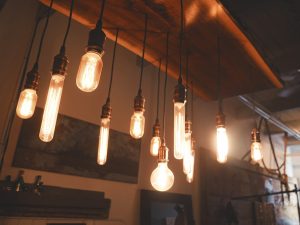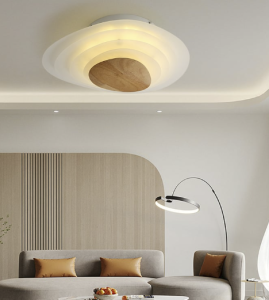The evolution of industrial pendant lights is a fascinating journey that intertwines with the broader narrative of industrialization itself. Originating in the late 19th and early 20th centuries, these fixtures were born out of necessity in factories and workshops, where practical illumination was paramount. The rise of electricity transformed the way spaces were lit, moving away from gas lamps and candles that had dominated previous eras.
Factories required robust lighting solutions that could withstand the rigors of a bustling work environment, leading to the creation of pendant lights that were not only functional but also durable. These early designs often featured metal shades and exposed bulbs, reflecting the utilitarian ethos of the time. As industries flourished, so did the aesthetic appeal of these lights, which began to be embraced in homes and commercial spaces alike.
As the decades progressed, industrial pendant lights Surora became emblematic of a certain rugged charm, often associated with the loft-style living that emerged in urban centers during the late 20th century. The revival of interest in vintage and retro design saw these fixtures being repurposed and celebrated for their historical significance. The raw materials used in their construction—such as steel, iron, and glass—evoked a sense of authenticity and craftsmanship that resonated with homeowners and designers seeking to create spaces that told a story.
This nostalgic appreciation for industrial design has only intensified in recent years, as more people look to incorporate elements of history into their modern living environments. Today, industrial pendant lights are not merely relics of the past; they are a testament to a design philosophy that values both form and function, seamlessly bridging the gap between history and contemporary aesthetics.
The Characteristics of Industrial Pendant Lights
Raw Materials and Authentic Design
Industrial pendant lights are characterized by their distinctive design elements that reflect their utilitarian origins. One of the most notable features is their use of raw materials, such as metal and glass, which lend an air of authenticity and ruggedness to any space. The shades are often constructed from materials like steel or aluminum, frequently finished in matte or distressed textures that enhance their industrial appeal.
Durability and Versatility in Design
This choice of materials not only contributes to the aesthetic but also ensures durability, making them suitable for various environments—from bustling kitchens to serene dining areas. Additionally, many industrial pendant lights showcase exposed bulbs, which add an element of warmth and intimacy while emphasizing the fixture’s functional roots. This design choice allows for a play on light and shadow, creating a dynamic atmosphere that can shift with the time of day.
Adaptability and Customization
Another defining characteristic of industrial pendant lights is their versatility in size and shape. Ranging from large, statement-making fixtures to smaller, more subtle designs, these lights can be adapted to fit a myriad of spaces and styles. The shapes often vary from classic dome forms to more geometric or abstract designs, allowing for creative expression in interior decor. Furthermore, many industrial pendant lights feature adjustable cords or chains, enabling homeowners to customize the height at which they hang. This adaptability not only enhances their functionality but also allows for a tailored look that can complement various design schemes—from minimalist to eclectic.
How to Incorporate Industrial Pendant Lights into Your Home Decor
Incorporating industrial pendant lights into your home decor can transform a space, infusing it with character and charm while maintaining a sense of modernity. One effective approach is to use these fixtures as focal points in key areas of your home. For instance, hanging a large industrial pendant light over a dining table can create an inviting atmosphere for family gatherings or dinner parties.
The warm glow emitted by the exposed bulb can enhance the dining experience, making it feel both intimate and stylish. Additionally, placing smaller pendant lights in clusters above kitchen islands or breakfast nooks can add visual interest while providing ample illumination for tasks such as cooking or reading. By strategically positioning these lights, you can create layers of light that enhance both functionality and aesthetics.
Another way to seamlessly integrate industrial pendant lights into your decor is by pairing them with complementary design elements. For example, if your home features exposed brick walls or reclaimed wood accents, industrial pendant lights can enhance these rustic features while adding an urban edge. Mixing materials is also key; consider combining metal fixtures with wooden furniture or soft textiles to create a balanced look that feels cohesive yet dynamic.
Furthermore, incorporating other industrial elements—such as metal shelving units or vintage-inspired decor—can help tie the room together, creating a harmonious environment that celebrates the beauty of industrial design. Ultimately, the key to successfully incorporating industrial pendant lights lies in thoughtful placement and pairing them with elements that resonate with your overall design vision.
The Modern Twist on Classic Industrial Pendant Light Design
While traditional industrial pendant lights are steeped in history and characterized by their rugged simplicity, contemporary interpretations have emerged that breathe new life into this classic design. Modern industrial pendant lights often incorporate sleek lines and innovative materials that reflect current design trends while still paying homage to their roots. For instance, designers are experimenting with mixed materials—combining metal with glass or even wood—to create unique fixtures that stand out in any setting.
These modern designs may feature geometric shapes or minimalist aesthetics that align with contemporary tastes while retaining the essence of industrial style. This evolution allows homeowners to enjoy the charm of industrial lighting without sacrificing modern sensibilities. Moreover, advancements in technology have also influenced the design of industrial pendant lights.
LED bulbs have become increasingly popular due to their energy efficiency and longevity, prompting designers to create fixtures that accommodate these modern light sources without compromising on style. Some contemporary designs even incorporate smart technology, allowing users to control brightness and color temperature through mobile apps or voice commands. This fusion of traditional aesthetics with cutting-edge technology exemplifies how industrial pendant lights have adapted to meet the needs of today’s consumers while remaining true to their historical significance.
As a result, modern interpretations of industrial pendant lights offer a fresh perspective on a timeless design, making them an appealing choice for those looking to enhance their spaces with both style and functionality.
Choosing the Right Industrial Pendant Light for Your Space
Selecting the right industrial pendant light for your space involves careful consideration of several factors that can influence both functionality and aesthetics. First and foremost, it’s essential to assess the size of your room and the specific area where you plan to install the fixture. A large dining area may benefit from a bold statement piece that draws attention and serves as a conversation starter, while smaller spaces might require more subtle designs that provide adequate lighting without overwhelming the room.
Additionally, consider the height at which you will hang the light; ensuring it is positioned correctly can enhance both its visual impact and its practical use. Another critical aspect to consider is the overall style and color palette of your space. Industrial pendant lights come in various finishes—ranging from polished metals to matte black or even vibrant colors—that can either complement or contrast with existing decor elements.
If your home features a predominantly neutral color scheme, opting for a striking light fixture can serve as an eye-catching focal point. Conversely, if your decor is already rich in texture and color, selecting a more understated light may be preferable to maintain balance within the space. Ultimately, choosing the right industrial pendant light requires a thoughtful approach that considers both practical needs and aesthetic desires, ensuring that your selection enhances your home’s overall ambiance.
DIY Industrial Pendant Light Ideas
Here is the rewritten text in English with 3-4 **Upcycle Your Way to Unique Lighting**
**Transforming Everyday Objects into Stylish Pendants**
For those who enjoy hands-on projects, creating your own industrial pendant light can be a rewarding endeavor that allows for personal expression while adding unique character to your home. One popular DIY approach involves repurposing vintage items such as old metal buckets or colanders into stylish light fixtures.
**Sustainable and Creative DIY Projects**
By simply adding a light socket kit and an exposed bulb, you can transform these everyday objects into eye-catching pendants that reflect your individual style. This not only provides an opportunity for creativity but also promotes sustainability by giving new life to items that might otherwise be discarded.
**Designing Your Own Pendant Light**
Another exciting DIY project involves constructing pendant lights from scratch using readily available materials like wood and metal piping. By designing your own frame or shades, you can customize dimensions and finishes to perfectly suit your space. For instance, creating a geometric wooden frame paired with an Edison bulb can evoke a modern industrial vibe while remaining true to traditional design principles.
**Personalizing Your Creation**
Additionally, painting or staining wood elements can further personalize your creation, allowing you to match it seamlessly with your existing decor. Engaging in DIY projects not only fosters creativity but also results in one-of-a-kind pieces that tell a story—making your home feel even more special.
Maintenance and Care for Industrial Pendant Lights
Maintaining industrial pendant lights is essential for preserving their aesthetic appeal and ensuring they function optimally over time. Regular cleaning is crucial; dust and grime can accumulate on metal surfaces and glass shades, dulling their shine and affecting light quality. To clean these fixtures effectively, use a soft cloth or microfiber towel along with mild soap and water for metal components.
For glass shades, a gentle glass cleaner can restore clarity without scratching the surface. It’s advisable to turn off power before cleaning any light fixture to ensure safety during maintenance tasks. In addition to regular cleaning, periodic inspections are vital for identifying any potential issues before they escalate into larger problems.
Check for loose connections or frayed wires that may compromise safety; if any concerns arise, consulting a professional electrician is recommended to address electrical issues properly. Furthermore, consider replacing bulbs as needed; opting for energy-efficient LED options not only reduces energy consumption but also minimizes heat output—extending the lifespan of your fixtures overall. By committing to routine maintenance and care practices, you can ensure that your industrial pendant lights remain beautiful and functional additions to your home for years to come.



